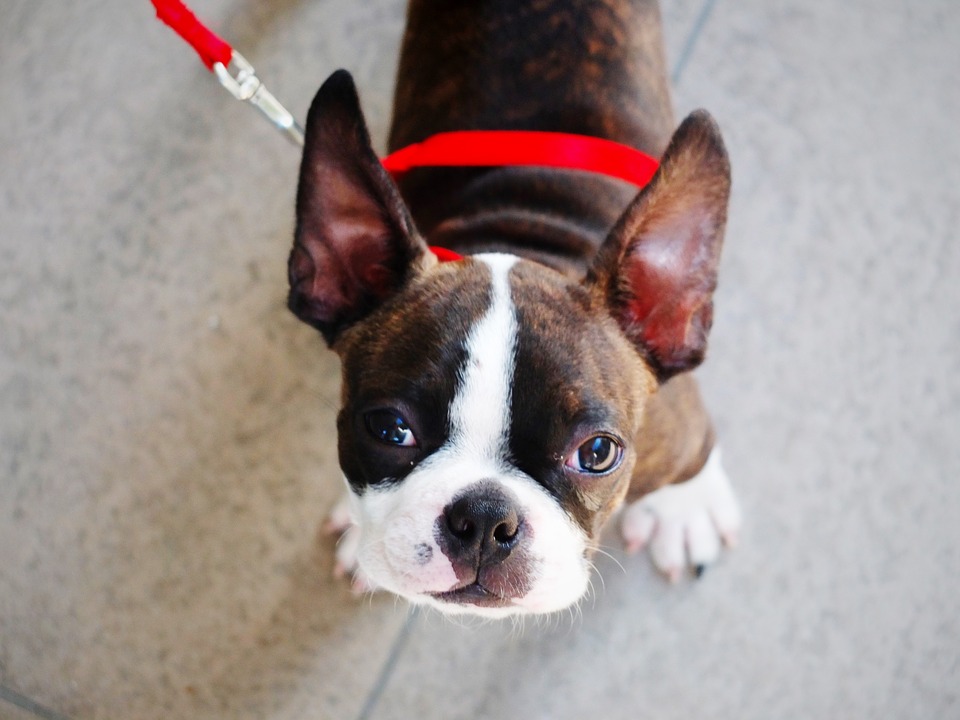 Boston Terriers wear a tuxedo coat and a cool attitude. This breed is friendly, portable and enthusiastic in everything they do. These terriers get along well with kids, other pets and pretty much everyone they meet. All in all, Boston Terriers are fantastic companions.
Boston Terriers wear a tuxedo coat and a cool attitude. This breed is friendly, portable and enthusiastic in everything they do. These terriers get along well with kids, other pets and pretty much everyone they meet. All in all, Boston Terriers are fantastic companions.
Physical Characteristics
The Boston Terrier is a lively, highly intelligent, smooth coated, short-head, compactly built, short-tailed and well-balanced dog. They are brindle, seal or black in color and evenly marked with white. The head is in proportion to the size of the dog and the expression indicates a higher degree of intelligence.
Boston Terriers have rather short and well knit bodies, with strong and neatly turned limbs. The tail is short and no feature is prominent that the dog appears badly proportioned. This breed conveys an impression of determination, strength and activity, with style of a high order; carriage easy and graceful.
Personality
Boston Terriers combine enthusiasm from the breed’s terrier ancestors with the gentle sweetness and good sense of their Bulldog ancestors. This breed also has a sly sense of humor and loves to clown around. The Boston is smart, enjoys plenty of attention and loves to be around people, especially if that means sitting on a lap or sharing a bed or couch. These terriers are definitely cuddlers and snugglers. While you can expect the Boston to be excited when greeting visitors, they will soon settle down once they have given the visitor an appropriate enthusiastic welcome. Boston Terriers can entertain themselves, especially with a favorite toy or two, but they would much rather be doing something with his or her family.
While some Boston Terriers have a reputation for being excessively active, that is not typical for the breed. A well-bred, well-socialized Boston is outgoing and playful but never obnoxiously demanding of time and attention. These terriers will adapt themselves to your schedule, but that doesn’t mean you can leave them alone all of the time. Bostons are major love bugs and require a family who will enjoy and desire his or her company.
Care
The best foods for a Boston Terrier contain beef, fish, wheat and yellow corn. Minimal grooming is required for this breed. They should be brushed fairly regularly, and bathed only when needed. Their faces should be wiped clean on a daily basis, and their nails should be clipped as necessary. Yearly checkups are needed for Boston Terriers. This breed also sheds moderately, so regular vacuuming is recommended if you keep this breed inside.
Health
Boston Terriers are prone to certain health problems. They are among the flat-faced, or brachycephalic, dog breeds. While having flat faces brings many health problems for Bostons, some minor such as snoring and snuffling, and some major, including life-threatening breathing difficulties that may require surgery to correct, if they can be corrected at all.
The corkscrew tail of Boston Terriers is associated with a condition known as hemivertebrae, a failure in the development of the bones of the spine. Some dogs may be asymptomatic, but others may show signs in puppyhood, including impaired movement and a lack of coordination in the hind legs. As a result, the puppy can end up paralyzed and surgery is often the only treatment.
The flat face feature also puts their eyes at risk of a number of injuries and diseases. The are a number of eye disorders that are known to occur in Boston Terriers, and eye problems are one of the most reported health problem in the breed. These problems include cataracts, corneal ulcers and glaucoma. In the scenario of juvenile cataracts, a genetic test has allowed breeders to identify dogs that carry the gene and reduce the incidence of the problem in the breed.
A small but significant number of Boston Terriers are deaf in one ear, and some are completely deaf. It’s crucial to discover this when the dog is as young as possible, because it will impact his training and socialization at a critical age.
This breed does share one problem with many other small breeds: a condition known as luxating patellas, or kneecaps that can easily slip out of place. While some cases are mild, severe cases require surgical repair. Boston Terriers are also prone to allergic conditions that usually affect the skin.
History
While everyone agrees that the Boston Terrier came into existence in the late 1800s in Boston Massachusetts, there are varying stories about how the breed came to be.
One story states that coachmen of wealthy families developed the breed by crossing Bulldogs and the now extinct English White Terrier to create a new dog-fighting breed. Another account states that a Bostonian named Robert C. Hooper imported a Bulldog/English Terrier cross named Judge from England in 1865 because he reminded Hooper of a dog he’d had in his childhood. Yet another story claims that Hooper purchased Judge from another Bostonian, William O’Brian, around 1870.
We may never known which story is true, but the fact is that there was, indeed, a dog named Judge, and that from him, came the breed we know today as the Boston Terrier. Judge was bred with Burnett’s Gyp (Kate), and one of their puppies was Wells’ Eph. Eph’s offspring are the ancestors of today’s Boston Terriers.
For more information the Boston Terrier or other dog breeds, don’t hesitate to contact us here at All Pets Veterinary Medical Center with the link below!
















Jessica Trinque liked this on Facebook.